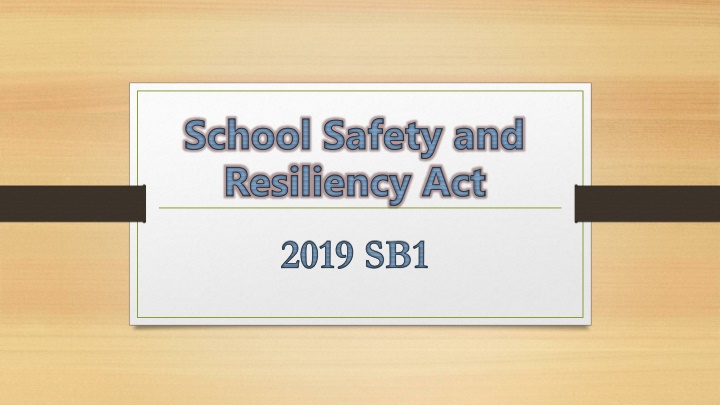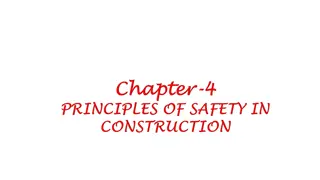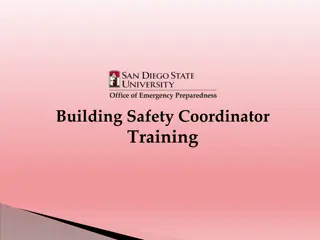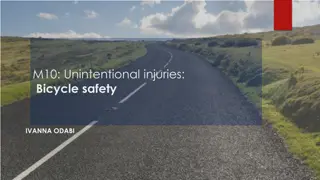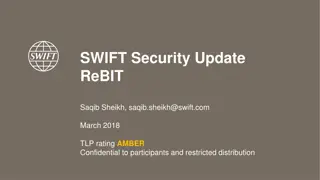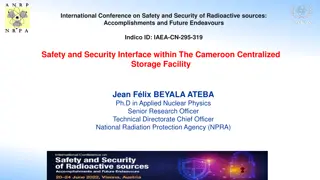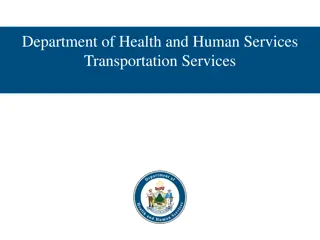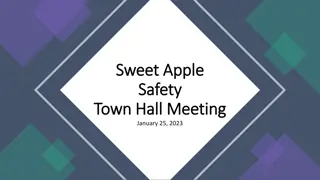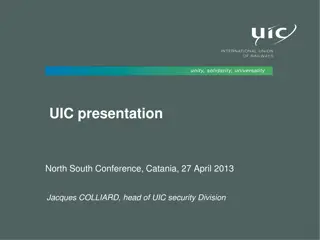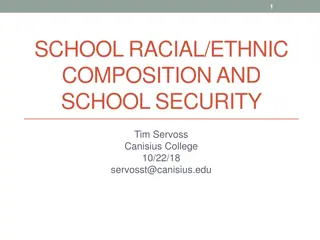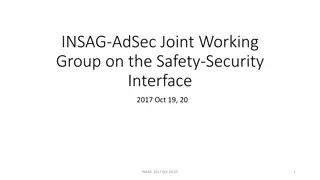Enhancing School Safety and Security Measures
The School Safety and Resiliency Act of 2019 (SB1) focuses on securing schools through personnel systems and structures that promote a culture of student connection. It mandates the assignment of certified School Resource Officers (SROs) to each school in a district. Subsequent changes clarified SRO deployment, arming, and the establishment of a state school security marshal office. The act emphasizes school risk assessment tools, compliance reviews, and annual reporting to enhance school safety and security.
Download Presentation

Please find below an Image/Link to download the presentation.
The content on the website is provided AS IS for your information and personal use only. It may not be sold, licensed, or shared on other websites without obtaining consent from the author.If you encounter any issues during the download, it is possible that the publisher has removed the file from their server.
You are allowed to download the files provided on this website for personal or commercial use, subject to the condition that they are used lawfully. All files are the property of their respective owners.
The content on the website is provided AS IS for your information and personal use only. It may not be sold, licensed, or shared on other websites without obtaining consent from the author.
E N D
Presentation Transcript
School Safety and Resiliency Act 2019 SB1
Securing Our Schools with PERSONNEL SYSTEMS AND STRUCTURES A CULTURE OF STUDENT CONNECTION
Securing Our Schools with Personnel Establishes that a certified School Resource Officer (SRO), hired either by a law enforcement agency or a local school board, shall be assigned to each school within a school district as funds and qualified personnel become available. Requires KCSS to report annually the number of SROs working in school districts and the source(s) of funding.
Securing Our Schools with Personnel Subsequent changes include: 2020 SB8 clarified that SROs may be assigned one per campus rather than school . Also, 2020 SB8 clarified that SROs shall be armed with a firearm. 2022 HB63 removed as funds and qualified personnel become available and added they shall fulfill the requirement of one SRO per campus by August 1, 2022 and if sufficient funds and qualified personnel are not available for every campus, approval in writing from the state school security marshal shall be sought until an SRO is assigned and working full-time on each campus in the district. In addition, 2022 HB63 provided authorization and outlines a means by which a local school district can establish their own police department.
Securing Our Schools with Personnel Establishes within the Department of Criminal Justice Training the office of the state school security marshal who shall enhance school safety by: * Developing and keeping updated a school security risk assessment tool in collaboration with the Kentucky Center for School Safety (KCSS) and the Kentucky Department of Education (KDE) to be used by local school districts to identify threats, vulnerabilities, and appropriate safety controls for each school in the district; * Conducting on site reviews to ensure compliance with the provisions of this act; State School Security Marshal Ben Wilcox
Securing Our Schools with Personnel * Presenting an annual report to the KCSS by September 1 of each year with a summary of findings and recommendations made regarding the school safety and security activity of the previous year; and * Confirming that each local school district superintendent has verified annually that all schools within the district have completed the school security risk assessment for the previous year. State School Security Marshal Ben Wilcox
Securing Our Schools with Personnel Establishes and Outlines the role of a district-level* school safety coordinator including: Completing the school safety coordinator training program developed by the Kentucky Center for School Safety (KCSS) that includes: Preparing/reviewing policies and procedures for conducting all hazards emergency response drills including hostage and active shooter training; Identifying and responding to threats to school safety; and Preparing for, conducting, and reviewing school security risk assessments. * 2020 SB8 established that this does not have to be a school administrator
Securing Our Schools with Personnel Role of School Safety Coordinator (cont d) . Designating a school safety and security threat assessment team at each school to identify and respond to students exhibiting behavior that indicates a potential threat; Providing training to school principals; and Ensuring the campus is toured annually with public safety agencies.
Securing Our Schools with Systems and Structures 2019 SB1 also amended KRS 158.162 to provide greater security within the school building by: Requiring the main entrance of the school to be controlled by an electronically locking door, a camera, and an intercom system; Requiring classroom doors be equipped with hardware that allows the doors to be locked from the outside but opened from the inside;
Securing Our Schools with Systems and Structures 2019 SB1 also amended KRS 158.162 to provide greater security within the school building by (cont d): Requiring classroom doors to remain closed and locked during instructional time (2020 SB8 allowed for exceptions to this when there is only one adult and one child in the classroom or when approved in writing by the state security marshal); Requiring classroom doors with windows to be equipped with material to quickly cover the window during a building lockdown; and Requiring schools to be in compliance by July 1, 2022 or risk ineligibility for approval for new building construction or expansion except for facility improvements that specifically address school safety and security measures.
Securing Our Schools with Systems and Structures Other provisions of 2019 SB1 include: Providing suicide prevention awareness information in person, by live streaming, or via a video recording to all students in grades six (6) through twelve (12). Requiring a minimum of one (1) hour of high-quality suicide prevention training including the recognition of signs and symptoms of possible mental illness to all school district employees with job duties requiring direct contact with students in grades six (6) through twelve (12).
Securing Our Schools with Systems and Structures Other provisions of 2019 SB1 include (cont d): Requiring a minimum of one (1) hour of training on how to respond to an active shooter situation for all school district employees with job duties requiring direct contact with students. The training shall be provided either in person, by live streaming, or via a video recording. 2020 SB8 shifted the responsibility of preparing this video from KDE to the KY Department of Criminal Justice Training after collaboration with KDE, the KCSS, and the KY Law Enforcement Council. Amended the statute on terroristic threatening to include making false statements by any means for the purpose of causing evacuation of a school building, school property, or school sanctioned activity; or for causing the cancellation of school classes or school activity; or creating fear of serious bodily harm among students, parents, or school personnel. Also, requires principal to make annual notification to all students of the provision of the statute and penalties for violation of Terroristic Threatening.
Securing Our Schools with a Culture of Student Connection Requires schools to employ, as funds and qualified personnel become available, at least one (1) school counselor in each school with the goal of having one (1) school counselor for every two hundred fifty (250) students and spending at least sixty percent (60%) of his or her time in direct services to students. 2020 SB8 amended this section to require one counselor in each school spending sixty percent (60%) of their time providing counseling and related services directly to students and having the goal of having one counselor or school-based mental health services provider who is employed by the district for every two hundred fifty (250) students, including the school counselor. Requires superintendents to annually report to KDE the number and placement of counselors in the district as well as the funding source and approximate percent of time devoted to each duty during the year.
Securing Our Schools with a Culture of Student Connection Instructs all schools to develop a trauma-informed approach as recommended by the federal Substance Abuse and Mental Health Services Administration in a school to foster a safe, stable, and understanding learning environment for all students and staff and ensuring that all students are known well by at least one (1) adult in the school setting. The school counselor or school-based mental health services provider shall facilitate the creation of a trauma- informed team to identify and assist students whose learning, behavior, and relationships have been impacted by trauma.
Securing Our Schools with a Culture of Student Connection The trauma-informed team shall provide training to other administrators, teachers, and staff on a trauma-informed approach. Instructs the KDE to provide a toolkit that includes guidance, strategies, behavioral interventions, practices, and techniques to assist school districts in developing a trauma-informed approach. Instructs each local board of education to develop a plan for implementing a trauma-informed approach in its schools that includes collaborating with local law enforcement to create procedures for notification of trauma-exposed students. Encourages the Department of KY State Police to receive training on issues pertaining to school and student safety and invites them to annually meet with local superintendents to discuss emergency response plans and emergency concerns as well as developing procedures to communicate instances of trauma-exposed students.
School Safety Funding FY21 FY22 FY23 FY24 School Safety Facility Upgrades (Bond Funds) 18,200,000 School Based Mental Health Professionals 7,412,500 7,412,50 7,412,500 7,412,500 Office State School Security Marshal 2,291,300 2,293,700 2,356,600 2,352,200 (Restricted Funds) Center for School Safety* *School district uses of the Center for School Safety funds - SROs, Alternative Ed. Programs, Intervention Services, Security Equipment, Training Programs, In-School Suspension, Community-Based Program 13,000,000 13,000,000 13,000,000 13,000,000
Questions? School Safety and Resiliency Act 2019 SB1 AS Amended by 2020 SB8 and 2022 HB63
